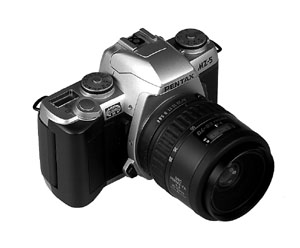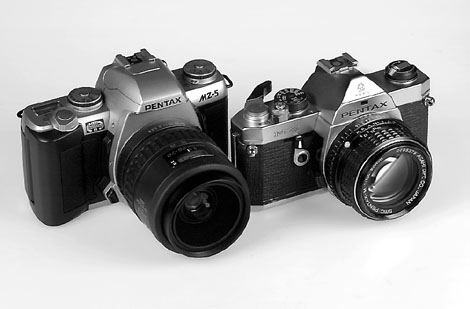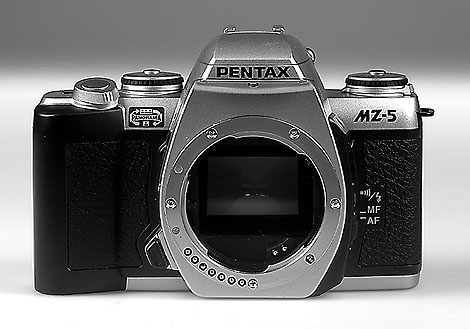 Once upon a time a Pentax was the Japanese camera for the British public.
From the mid-60s to the mid-80s they dominated the marketplace with a
range of consistently good models. Affordable enough for the average
enthusiast, reliable enough for the professional and cool enough for The
Beatles their list of classics takes some beating; Spotmatic F, ESII,
K1000, ME Super, MX, LX and P30. It was only with the switch to autofocus
that they started to lose their way - despite starting it all off with
their own ME-F.
Once upon a time a Pentax was the Japanese camera for the British public.
From the mid-60s to the mid-80s they dominated the marketplace with a
range of consistently good models. Affordable enough for the average
enthusiast, reliable enough for the professional and cool enough for The
Beatles their list of classics takes some beating; Spotmatic F, ESII,
K1000, ME Super, MX, LX and P30. It was only with the switch to autofocus
that they started to lose their way - despite starting it all off with
their own ME-F.The clean lines and compactness of previous models seemed to go out the window overnight and never really returned. The company seemed not to mind and turned their attention more and more to the compact market - where they quickly became, and remain, hugely successful.
Pentax seemed to make little effort keep pace with Minolta, Nikon and Canon in the AF market and their range of 35mm SLRs lost the family resemblance of days gone by. Their unusual off-centre hotshoes made a lot of sense photographically but did little for the aesthetics. By contrast the opposition designed cameras that looked "right" to the increasingly fashion-conscious public. Some independent lens manufacturers even began to exclude KAF fit models from their newer lines, presumably due to a drop in demand.
Not that Pentax became a minor player in the SLR game by any means, but their low profile and quirky product line placed them a level below the Top Three (what ever happened to the Big Five - or indeed the Fab Four?).
But that's all history now - Pentax are back in the game with new products, advertising campaigns and ideas. The MZ-5 is hopefully the first in a new breed of cameras that borrow more than a little of the inspiration of their old breed of cameras.
The MZ-5 has been described as "retro". Bo***cks! It's just good design. Despite being a fully featured AF SLR there is not a thumbwheel in sight - the only other AF camera which can make that claim is the Nikon F4 at � 1,700.
Instead the MZ-5 uses the bizarre system of a shutter speed dial and aperture ring to select exposure and modes. At a glance you can see which shutter speed and aperture are selected - or which are set to automatic. If the aperture is at 'A' then, surprise, surprise, the aperture will be automatically selected. The same applies to the shutter dial and, if both are set to 'A' we have programmed exposure. Neither on 'A' gives manual with a useful "digital needle" in the viewfinder.
Why we ever departed from this tried and trusted system is anybody's guess. Suggestions to: Minolta Camera Co. Japan Ltd... Actually that's not quite fair as it was Pentax who first introduced up/down buttons - on the ME Super - in any case. For those irrevocably caught up in 90s camera design jargon the MZ-5's LCD will also translate these hyper-logical mechanical settings into the usual P, Tv, Av and M.
And the resemblance to those classic Pentax models does not just end here; the silver livery, "M" designation and compact design all allude back to the MX/ME range which were Pentax's crowning glory.
On the other side of the prism we find a "traditional" exposure compensation dial which allows plus or minus three stops in half stop increments. I prefer arrangement this to the common 1/3 stop variety as I often feel 1/3 stop adjustment is too little but 2/3 is too much. The same dial can be used to adjust the ISO settings manually (6-6400) and select from three metering patterns. These are the usual Matrix, Centre Weighted and Spot modes. Don't take that last one for granted - no manual focus Pentax ever enjoyed spot metering.
The lock switch - also apparently modelled on the Spotmatic/K1000/MX design - also controls the advance mode (single or 2fps) and self timer. Apart from these there are only a Spot AF button, Pentax's ubiquitous Panorama switch and an AF/MF control.
At last we have a clean and simple layout with exactly the features required and nothing more to confuse and confound. Adjusting all settings to their green markings denotes full automation for beginners and manualphobes.

While the MZ-5 is the smallest camera of its kind as well as one of the lightest, it still uses metal parts where they count most - on the film gate and lens mount - for strength and minimising of wear. This is not always the case on cheaper AF SLRs.
The standard lens is an AF 28-70mm �4 - much faster than the usual bundled 28-80mm �4.5-5.6s. The �4 aperture is constant throughout the zoom range and is a more sensible idea than say an �3.5-4.5 arrangement, especially for those who use non-TTL flash. The penalty for this is that the lens is not quite as compact as the body deserves. Perhaps something more akin to Minolta's good old AF 35-70mm �4 might have been more appropriate for such a compact body.
Call me a Luddite if you like, but I thought the MZ-5 and my old Pentax M 40mm �2.8 "pancake" made a superb partnership, even though it sacrifices some of the exposure and metering modes. In general if you want to go for manual focus lenses the KA mounts are a better option in terms of functionality.
 Autofocus proved fast and precise, literally snapping between points of
focus. A spot focus button conveniently placed under the thumb proves
useful in situations where the wide array falls foul of intrusive
foreground detail. Against this the Pentax autofocus system remains
noisier than most competing cameras and tends to hunt frantically - and
somewhat violently if it does get confused.
Autofocus proved fast and precise, literally snapping between points of
focus. A spot focus button conveniently placed under the thumb proves
useful in situations where the wide array falls foul of intrusive
foreground detail. Against this the Pentax autofocus system remains
noisier than most competing cameras and tends to hunt frantically - and
somewhat violently if it does get confused.The focusing noise - while not unacceptably high - is in fact the loudest aspect of the camera's operation by virtue of a remarkably silent shutter, mirror and wind on mechanism. In manual mode it is a very quiet and unobtrusive device.
Pentax have continued their current practice by including a panoramic switch. This works simply by blading down the film gate and focusing screen to around 36 x 13mm. Isn't it funny, but this panoramic masking used to get slated on quality grounds while exactly the same feature is applauded on APS!
Handling and ergonomics are good with the exception of the lock switch which is, in my opinion, fitted backwards. A little extra contouring might make it a little more comfortable to hold but it is basically fine as it is. My wife has small hands and was delighted to have found a camera that she could hold with comfort.
The flash shoe is now placed in the standard position and is fully compatible with the sophisticated AF-500FTZ flashgun - even if it does dwarf the camera itself.
If you don't need the advanced features of the AF-500FTZ or AF-330FTZ the MZ-5 has the usual pop up GN11 TTL flash atop the prism. As with the lenses you can use many older Pentax flash units - such as the AF200T and AF280T - which still provide TTL compatibility and dedicated functions.
This backwards compatibility is one of the most important features of the MZ-5. A user of older Pentax equipment - such as myself - can confidently add an MZ-5 to their line up without having to mothball their current fleet of lenses and flashguns.
If you are after the latest in male jewellery the MZ-5 is not the camera for you - it lacks the bells, whistles, go faster stripes and "street credibility" of some of the competition and provides instead simplicity and a range of sensible features.
It might seem a little pricey compared to similar models but if you want something light, compact, easy to use and, above all, functional, Pentax's silver machine may be the perfect tool for the job.
-Andy Aitken
Return to Photon September 96 contents